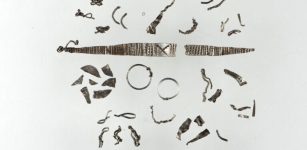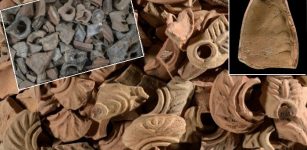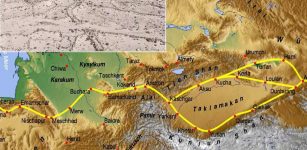Amanitore – Nubian Warrior Queen And Her Pyramids
David Tee - AncientPages.com - We often say that a piece of fruit does not fall far from the tree. In Amanitore’s case, this may be very accurate. She was a warrior Queen like her mother, grandmother, and great-grandmother before her.
Amanitore at Wad ban Naqa, an ancient town of the Kushitic Kingdom of Meroë in present-day Sudan. Barge pedestal on display in the Egyptian Museum of Berlin found in Wad ben Naga. Image credit: - CC BY-SA 2.0
Historical records have her reign recorded at approx. 1 BC, depending on which document you believe, she ruled with Natakamani, King of Kush, though it is unclear if she was the mother or the wife. She held great power, and if she commanded a king to commit suicide, he was obliged to follow the command by law.
Some ancient texts have her as ruler and not some shadowy support figure. In any case, she and Natakamani were the last great builders and rulers of Kush.
Amanitore was the ruler or co-ruler of Meroe, the great city in Kush. There needs to be some clarification as to the land which she ruled. Often, Nubia is transposed over the name Kush, but Nubia was the term used for the general geographical area.
The name Nubia did not come until about 300 to 400 years after the death of Amanitore. No matter the name, Meroe or Kush enjoyed a good relationship with Egypt, and it is debatable who influenced whom during ancient times.
At one time, the rulers of Kush ruled Egypt, but when the Assyrians came to the land, they defeated the Kushites.
The Warrior Queens Of Nubia
The warrior queens were not afraid of war or easily intimidated.
Queen Amanirenas spent five years fighting the Romans even though she was blind in one eye. Amanishakheto defeated a Roman invading force, while their mother and grandmother, Shanakdakheto, were depicted as warriors and shown in battle.
Credit: Public Domain
Amanitore was born into this tradition, and although she is depicted as overweight and out of shape, she is said to be very athletic. Her successor or daughter, Amanitaraqide, took over for Amanitore, but their combined time of reign lasted only 49 years. No records exist to show how long each remained in power.
Amanitore’s Building Legacy
Like many ancient rulers, Amanitore left a sizeable real estate legacy. She and her co-ruler (son or husband?), Natakamani built over 200 pyramids during their reign. It is worth mentioning that these pyramids were on a different, more significant scale than the famous Egyptian ones.
Amanitore’s burial pyramid measures only 6 square meters at the base and is not a true pyramid. It is unknown if she had any jewels when she was buried. An Italian treasure hunter, Giuseppe Ferlini, was known to take gems buried with their owners. He was not known for preserving the pyramids in his hunt for buried treasure.
The couple also went on to restore the temples of Amun at Meroe and Napata. They also built new temples for Amun at Naqa and Amara. Yet there were other construction products. The two also built reservoirs at Meroe to maintain a good water supply for their people.
Is Amanitore Referred To In The Bible?
It is a very debatable question. In the Book of Acts, Phillip is told by an angel of God to meet an Ethiopian eunuch who served a queen called Candace.
*Candace” can also be spelled Kandace, the royal title for the warrior queens.
Perhaps Amanitore was still on the throne, but it is also possible that her successor, Amanitaraqide, had taken over by this time. Without accurate records to say otherwise, the name of that Biblically-mentioned Queen remains in doubt.
Philip would have been alive around 30 AD or a little later when this event took place. But the Bible is not specific about it.
The tradition of the warrior queen did not end with the death of Amanitore. Many of her successors carried on the practice. However, records may need more detail. What is known is that Amanitore was the last great Meroe ruler who dedicated much of her life to the building.
Her legacy remains in her real estate work and not her battles.
Written by – David Tee - AncientPages.com
Updated on Nov 19, 2023
Copyright © AncientPages.com All rights reserved. This material may not be published, broadcast, rewritten or redistributed in whole or part without the express written permission of AncientPages.com
Expand for references





















